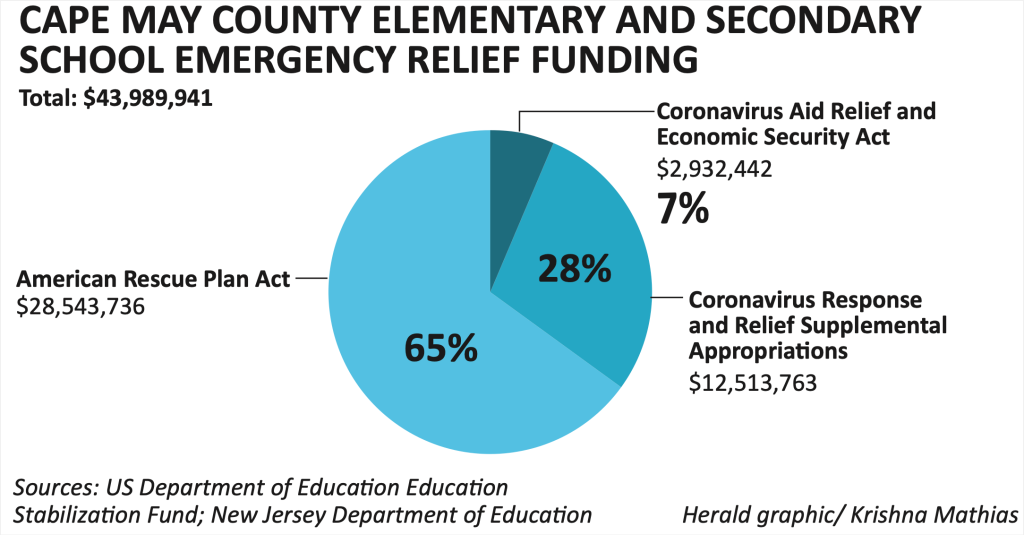COURT HOUSE – Over the last two years, the federal government has engaged in an unprecedented funding spree aimed at education needs created by the pandemic.
In that span of time, Congress appropriated $275 billion across four broad areas of education funding. It did so largely through three separate funding acts – Coronavirus Aid Relief and Economic Security Act (CARES), Coronavirus Response and Relief Supplemental Appropriations (CRRSA), and American Rescue Plan Act (ARPA).
The broad funding areas were Elementary and Secondary School Emergency Relief (ESSER) in the amount of $189.5 billion, Governor Emergency Education Relief (GEER) for $4.2 billion, Emergency Assistance to Non-Public Schools (EANS) in the amount of $5.5 billion and Higher Education Emergency Relief (HEER) for $74.9 billion.
While it may seem pedantic to enumerate all the national funding acts and the variety of ways in which the funding was categorized, the important message is that this level of funding appears to have overwhelmed the nation’s school districts. The spending has been slow.
The federal dashboard shows that, as of four months ago, only 12% of all elementary and secondary relief funding had been spent. This is across all ESSER funding of almost $190 billion. A Brookings Institution study shows that only 5% of the ARPA funding aimed at elementary and secondary schools has been spent, as of Jan. 31, 2022.
The big problem is that barring some change in the laws governing the funding, this huge influx of money must be obligated and then spent by a certain deadline to avoid its return to the U.S. Department of the Treasury.
Across this maze of acronyms and funding amounts, New Jersey received a total of $6.2 billion. Of that, Cape May County elementary and secondary public school districts were allocated a total of $44 million across all funding acts.
Twenty states have created public-facing dashboards to allow the public to see how the money is being spent. New Jersey is not one of those states. Transparency in the spending of ESSER funds in New Jersey is a challenge. What is known with some degree of certainty is how much was allocated to each municipal school district, the two county districts, and the one regional district, which the Herald reported on in February, showing the amounts per district.
Of that $44 million, $2.9 million must be obligated by Sept. 30, 2022, $12.5 million must be obligated by Sept. 30, 2023, and the bulk of the money, $28.5 million, by Sept. 30, 2024.
Most school districts are using the funds in order of the expiration dates, provided that the use they wish to address fits with the acceptable uses of each act’s funding.
The problem is that the bulk of the money is in ARPA funding, setting up a situation where the pace of spending will have to increase rapidly to meet the deadlines.
The spending pattern has also been impacted by the schedules of the federal government in finally allocating the funds to the states. It was just three months ago that the U.S. Department of Education announced it had completed the allocation of $122 billion in ARPA ESSER funding to all the state education agencies.
Admittedly, New Jersey was allocated its funding by the end of summer 2021, but spending remains slow.
What this boils down to is that the latest federal reporting on state and local educational agency spending in New Jersey shows 83% of the much smaller $257 million CARES ESSER pot has been spent. Of the $1.2 billion in CRRSA funding for New Jersey elementary and secondary schools, 20.7% has been spent. The most recent and by far largest allocation from the ARPA of $2.8 billion for New Jersey public schools shows less than 1% spent.
The Herald’s February article showed plans to use ESSER funding for capital projects in several school districts. At that time, it was known that Lower Cape May Regional had included the use of ESSER funds in its capital projects to lower the amount of a bond issue.
In March, it was learned that Lower Township Elementary followed suit, also including ESSER funds in capital improvement of facilities.
These insights into the use of ESSER monies are public but in a sporadic way. There is no source of information that records the use of historic funding levels by district. The public, if interested, must work hard to get at any data on spending.
With all the required plans and necessary reporting established by the state Department of Education, no public-facing website is available concerning the details of spending of over $6.2 billion in federal education relief funds.
It is also useful to keep in mind that while spending plans may be found, the money does not have to be spent in line with the plans. Plans are not spending.
It is known that a 20% minimum of the ARPA ESSER funding must be allocated to learning recovery by law. The specifics of that use, things like summer learning programs, accelerated learning initiatives, and the like, are concepts without specifics.
What is known from the federal level tracking is that spending has been slow, and experts are warning of a “fiscal cliff” where it will accelerate as “use it or lose it” dates approach for each act’s funding.
What is also unclear is how state and local education officials plan to confirm that the money achieved its desired ends. Baseline data is needed to measure achievement in dealing with learning loss, for example.
It is likely that various methodologies are being considered or even used to meet the need for measurement, but, if so, they are not presented in a way that gives the public meaningful insight.
It is easy to find numerous organizations and nonprofit think tanks trying to analyze the ESSER spending data to see how it is being used and whether it is achieving its intended purpose. There are numerous webinars and reports available. All of them agree on one thing. The data is not there.
State education agencies are collecting reports from local education agencies and forwarding some data to federal education agencies. Easily accessible data for the public has not been a key element in that process.
To contact Vince Conti, email vconti@cmcherald.com.








